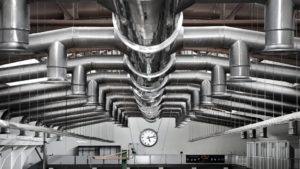Passive Versus Mechanical Ventilation for Metal Buildings

When it comes to ventilation for metal buildings, you have choices. With unpowered and powered options available, and a wide range of options within both categories, it’s important to select the building ventilation system that suits your structure’s purpose and needs. Read on for an overview of passive versus mechanical ventilation systems.
Passive (Unpowered) Ventilation Systems
A passive ventilation system uses differences in air pressure, aided by strategically placed openings in a building, to encourage natural airflow. One metal building accessory that can aid in this approach? The ridge vent. This handy tool allows hot air which rises to the roof to escape, working in tandem with soffits that bring fresh air in and aid in circulation.
Pros of passive or unpowered ventilation for metal buildings include the fact that they are low-maintenance, with zero operating costs. They are also made to work with the design of the building, allowing fresh air in and, as heat rises, releasing the hot air out. This simple design means the risk of it being rendered inoperable are low.
Regarding the cons of a passive system, if you live in an area with high humidity, it may be difficult to achieve adequate airflow. Also, it may not be enough ventilation for heavy-duty operations that include livestock, chemicals or industrial processes. If your metal building contains animals, fumes or smoke, you may require a higher industrial-grade power system.
Mechanical (Powered) Ventilation Systems
A mechanical ventilation system uses ducts and fans powered by electricity to circulate fresh air into and throughout a space. An example of mechanical ventilation is a wall-mount fan that, when turned on, pushes air through the building horizontally.
Pros of mechanical or powered ventilation for metal buildings include improved control over airflow, something ideal for humid areas. It also works well for facilities that emit smoke, or house chemicals or animals, as it ushers offensive odors and fumes out and brings fresh air in.
Regarding the cons of such a system, since it is powered, there are added electrical costs. Powered systems also have more moving parts. This increases costs associated with maintenance and repairs, as parts can break or wear out, and can lead to inconveniences if the system is down for an extended period of time.
Overall, powered ventilation works great for larger buildings which house industrial operations and demand more control of airflow. A powered system makes it easy to remove fumes, as well as hot, stale air, and replace it with air that is clean and healthy.
Metal building ventilation requirements vary depending on building size, the building’s use and location. Do you need help determining which ventilation system is best for your steel building? Contact us. We would love to discuss the options that are best for your needs.



